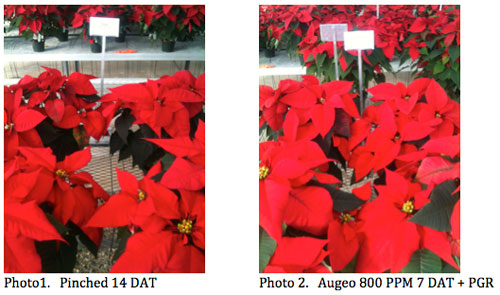Fine tuning the Augeo no-pinch poinsettia program
by Dave Barcel, OHP senior technical manager
Our no-pinch poinsettia program featuring sprays of the PGR Augeo® has been ongoing and continuously evaluated for the past 3 years. The results have been very encouraging and testing in 2012 has uncovered more detailed uses.
Dr. Jim Barrett, University of Florida, tested Augeo on poinsettia varieties Prestige, Prestige Early Red, Jubilee Red, Tikal and Prima in 2012. Treatments consisted of a pinched plant, and plants treated with Augeo sprays of 800 PPM, 1200 PPM or 1600 PPM at 7 days after transplant (transplant date Aug. 8, 2012). Dr. Barrett also included the addition of PGR treatments to control plant height. This was either an early B-Nine® and Cycocel® application using 1250 PPM and 1500 PPM, respectively, at 28 days after transplant on the Augeo 800 PPM treatment or using a paclobutrazol (such as OHP's Paczol®) low dose drench at 0.1 PPM on Oct. 24 and again on Nov. 7 using 0.2 PPM on remaining Augeo treatments. (These are rates for Northern Florida. Growers in the Northern U.S. should adjust accordingly.)
 Prima finished with comparable results to that of
a pinched crop and appears to be a very good candidate
for the Augeo no-pinch program. Photo 1
and Photo 2 show the comparison of the Prima
pinch crop vs. the Augeo 800 PPM crop and PGR
program.
Based on three years of testing, the best recommendation
for using Augeo on poinsettias is to
apply a spray of 800 PPM for Prima and slightly
higher rates of 1200 PPM or 1600 PPM for Prestige, Prestige Early Red or Jubilee.
Prima finished with comparable results to that of
a pinched crop and appears to be a very good candidate
for the Augeo no-pinch program. Photo 1
and Photo 2 show the comparison of the Prima
pinch crop vs. the Augeo 800 PPM crop and PGR
program.
Based on three years of testing, the best recommendation
for using Augeo on poinsettias is to
apply a spray of 800 PPM for Prima and slightly
higher rates of 1200 PPM or 1600 PPM for Prestige, Prestige Early Red or Jubilee.
The lower rates applied once will need the addition of PGRs to control height of the main shoot. Augeo sprays will yellow up the crop for a period of several weeks after application but plants will grow out of it by finish time.
Augeo must also be allowed to dry on the plant for a minimum of six (6) hours and growers should wait until the following day for any overhead watering. Since every grower's location can differ in light, temperature, feed rates etc. it is recommended that growers test Augeo for the varieties to be grown in order to better determine the best rate for their location and growing practices.
